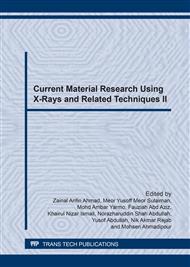[1]
Y.P. Kim, G.S. Lee, J.W. Kim, M.S. Kim, H.S. Ahn, J.Y. Lim, J.K. Hyun., Phosphate glass fibres promote neurite outgrowth and early regeneration in a peripheral nerve injury model, J. Eng. 9 (2015) 236-246.
DOI: 10.1002/term.1626
Google Scholar
[2]
E.A.A. Neel, I. Ahmed, J. Pratten, S.N. Nazhat, J.C. Knowles. Characterisation of antimicrobial copper releasing degradable phosphate glass fibres, Biomaterials. 26 (2005) 2247-2254.
DOI: 10.1016/j.biomaterials.2004.07.024
Google Scholar
[3]
M. Sava, B.A. Sava, A. Boroica, L. Ursu, M. Elisa, Efficiency of vitreous Phosphato-Potssium fertilizers on autumn corps, Sci. Papers. 53 (2010) 187-193.
Google Scholar
[4]
S. Murphy, D. Boyd, S. Moane, M. Bennett, The effect of composition on ion release from Ca–Sr–Na–Zn–Si glass bone grafts, J. Mater. Science. 11 (2009) 2207-2214.
DOI: 10.1007/s10856-009-3789-y
Google Scholar
[5]
J. C. Knowles, K. Franks, I. Abrahams, Investigation of the solubility and ion release in the glass system K2O–Na2O–CaO–P2O5, Biomaterials. 22 (2001) 3091-3096.
DOI: 10.1016/s0142-9612(01)00057-6
Google Scholar
[6]
M.R. Majhi, R. Pyare, S.P. Singh, Studies on preparation and characterizations of CaO–Na2O–SiO2–P2O5 bioglass ceramics substituted with Li2O, K2O, ZnO, MgO, and B2O3, J. Sci. Ind. Eng. 2(9) (2011) 1-9.
Google Scholar
[7]
R. Shah, A. Sinanan. N. Hunt, M. Lewis, Craniofacial muscle engineering using a 3-dimensional glass fibre constructs, Biomaterials. 26 (2005) 1497-1505.
DOI: 10.1016/j.biomaterials.2004.04.049
Google Scholar
[8]
E.A.A. Neel, I. Ahmed, J. Pratten, S. N, Nazhat Effect of iron on the surface, degradation and ion release properties of phosphate-based glass fibres, Biomaterials. 1 (2005) 553-563.
DOI: 10.1016/j.actbio.2005.05.001
Google Scholar
[9]
H. Gao, T. Tan, D. Wang, Dissolution mechanism and release kinetics of phosphate controlled release glasses in aqueous medium, J. Cont. Release. 96 (2004) 29-36.
DOI: 10.1016/j.jconrel.2003.12.031
Google Scholar
[10]
M. Tylkowski, D.S. Brauer, Mixed alkali effects in Bioglass® 45S5. J. Non-Cryst. Solids, 376 (2013) 175-181.
DOI: 10.1016/j.jnoncrysol.2013.05.039
Google Scholar
[11]
R. Brückner, M. Tylkowski, L. Hupa, D. Brauer, Controlling the ion release from mixed alkali bioactive glasses by varying modifier ionic radii and molar volume. J. Mater. Chemistry. 18 (2016) 3121-3134.
DOI: 10.1039/c5tb02426a
Google Scholar
[12]
M. Karabulut, E. Melnik, R. Stefan, G. Marasinghe, K. Ray, C.S. Kurkjian, D.E. Day, Mechanical and structural properties of phosphate glasses, J. Non. Cryst. Solids, 288 (2001) 8-17.
DOI: 10.1016/s0022-3093(01)00615-9
Google Scholar
[13]
Q. Yajun, W. Zhiqiang, Z. Shangru, J. Shuwen, L. Hai, Study of structures and properties of ZnO-Sb2O3-P2O5-Na2O glasses, Mater. Science-Poland. 32 (2014) 414-418.
DOI: 10.2478/s13536-014-0214-0
Google Scholar


